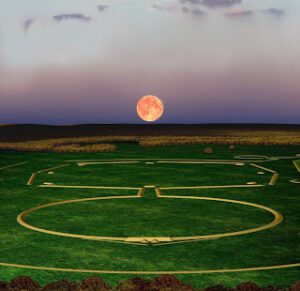Ohio has a new state symbol! If you’re from Ohio, you can probably name our official state bird and tree. You probably even know our official state rock song. You might not know that our state has other symbols as well, such as a state fossil, insect, reptile and gemstone. Check out Ohio History Central for a complete listing of symbols.
On June 7th, 2006 Gov. Bob Taft signed into law a bill making the Newark Earthworks the states prehistoric monument. The 4th grade class of William E. Miller Elementary School in Newark came up with the idea after spending a year learning about the site, which already had been recognized as one of the 70 wonders of the ancient world by Cambridge University archaeologist Chris Scarre, who worked with an international committee of archaeologists to select sites for this honor. Only two other sites in the United States made this list. These were Chaco Canyon in New Mexico and Cahokia Mounds in Illinois. The kids from Miller Elementary worked with their teachers Mary Borgia and Linda Woolard and with Sen. Jay Hottinger to craft the bill. They traveled to the State House on several occasions to give testimony on the bill before various committees and to the full House and Senate. They shared what they learned and, more importantly, conveyed their passion for this amazing site. One of the students told the House committee, “The earthworks talk to us. And we really do believe we have so much more to learn about them.” As a result of the hard work of these students and their teachers, Ohio becomes only the third state to honor Americas indigenous peoples with a state symbol and the first to designate a state prehistoric monument.
In 1991, California named a 7,000-year-old chipped stone bear effigy as that states prehistoric artifact. In 1995, Nevada named a 2,000-year-old duck decoy, made from reeds and feathers, as its state artifact. Ohio has many magnificent prehistoric monuments, any of which might have been considered for such an honor. For example, Serpent Mound, in Adams County, is one of the largest effigy mounds in the world and its probably Ohios most famous mound.
So did the Legislature make a mistake by naming the Newark Earthworks the state prehistoric monument? Although less renowned than Serpent Mound, the Newark Earthworks is an amazing site! It is the largest connected set of geometric earthworks ever built. Two monumental circular enclosures, an enormous oval, a square, and a huge octagon originally covered an area of more than four square miles. These geometric earthworks were interconnected by a series of parallel walls that may have served as sacred roads for the participants in periodic rituals. One of these roads may have extended more than sixty miles to the southwest, connecting the Newark Earthworks with the many contemporary earthworks located in the Scioto River Valley, north and south of modern Chillicothe. For more information about this Great Hopewell Road. The Newark Earthworks were built by the ancient people whom archaeologists have called the Hopewell culture.
The Hopewell culture lived in southern and central Ohio from about 100 B.C. to A.D. 500. They were farmers, fishers, hunters, and gatherers of wild plant foods. They lived in small villages scattered along the major tributaries of the Ohio River. The Hopewell culture built many monumental ceremonial centers. The most notable examples were found at Marietta, Portsmouth, and near Cincinnati; and nowhere was there a greater abundance and diversity of mounds and enclosures than along the Scioto River and Paint Creek valleys near Chillicothe.
The Newark Earthworks, however, are the grandest architectural achievement of the Hopewell culture. The Octagon Earthworks are one of the best-preserved and most remarkable components of the Newark Earthworks. It consists of a circular enclosure connected to an octagon by a short section of parallel walls. Professors Ray Hively and Robert Horn, of Earlham College in Indiana, discovered that the Hopewell builders aligned these earthworks to the complicated cycle of risings and settings of the moon. A total of four moonrise alignments and four corresponding moonset alignments define the intricate 18.6-year-long lunar cycle. Hively and Horn found all of these alignments in the architecture of Newark’s Octagon Earthworks. These earthworks are a sort of cosmic alarm clock, set to go off every 18.6 years [see http://www.OctagonMoonrise.org for more information]. For all these reasons, Stephen Oravecz, writing in the June 9th Tribune Chronicle newspaper, expressed his opinion that the Legislature got it right when it designated the Newark Earthworks as the states prehistoric monument.
In 2006 there will be a rare opportunity to participate in the special magic of the Newark Earthworks! This is the year in which the moon will rise at its northernmost point on the horizon. The Ohio Historical Society is hosting a moonrise celebration at the Octagon Earthworks on October 11th. Please join us as we watch the moon rise along the avenue defined by the parallel walls that connect the circle to the octagon.
For more information about this incredible once-in-a-generation event, see https://www.ohiohistory.org/learn/collections/archaeology/archaeology-blog/june-2006/state-prehistoric-monument
